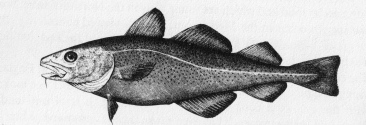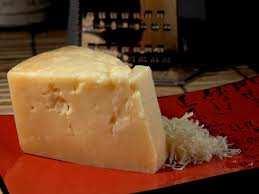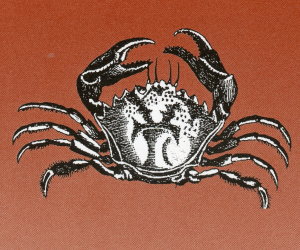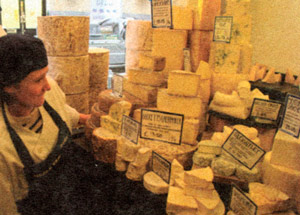Recipes that pair cheese with fish; a heretical notion?
The question by now ought to be moot, but in the unremote past, at least in the United States, a dialogue if not quite a debate crackled in the press over the use of cheese and fish together, notwithstanding traditional classics like coquille St. Jacque or perhaps because of widespread abominations like tuna casseroles and ‘melts.’ Italians, we are told, at least outside of eccentric Sicily, continue to abhor cheese with fish, and refuse even a shower of Parmesan over pasta with clam sauce.

R. W. Apple considered the pairing unconventional in his 2005 eulogy to Uglesich’s, the peerless New Orleans seafood dive. “One of the restaurants idiosyncrasies is the liberal use of cheese with shellfish--liked by some and detested by others.” (“A Lunchtime Institution”) His wife disliked the fried oysters with blue cheese there, but we cannot understand why; anyone who ever had the privilege of eating lunch at Uglesich’s (no dinner served) knew better than to question anything Gail and Anthony created in their kitchen.
Robert Trachtenberg devoted an article to the dispute for The New York Times Magazine in 2008. He likes his seafood pasta seasoned with grated cheese and has suffered serial indignities due to his predilection. In a Milan restaurant he made his standing request:
“The waiter didn’t yell at me exactly. Rather, he turned to the nearest table and started screaming at them--something about ruining his food, the culture, the country, but then I lost the thread. That was the beginning of the end. In Venice, I was chastened for putting cheese on shrimp rigatoni. In Los Angeles, an Italian waiter looked around anxiously as he shredded some Parmesan onto my plate. “I could lose my job for this,” he said. In New York, the menu at DaSilvano stated in no uncertain terms, “No cheese served on seafood at any time.” (“Just Grate”)

Some cheese with that pasta?
Trachtenberg’s informal survey of famous Italian chefs and food writers yielded a split decision. Italian nationals could not accept the notion; Americans tended to find their rigid stance silly. He cites David Pasternak: “It’s just a blanket rule they’ve imposed on themselves. They don’t want to try anything new.” (“Just Grate”)
From August 2007 through February of 2010, a period of some two and a half years, dozens of bloggers at www.chowhound.com staged their own debate on the subject, proof perhaps only that bloggers get indefatigable if not addicted in terms of their pastime.
The stricture against serving cheese and fish together, to the extent a rationale is articulated, would appear to stem from the notion that the flavor of seafood is delicate and that of cheese strong. The cheese, its opponents say, overwhelms the fish. When Hugh Fearnley-Whittingstall addresses “the knotty question whether cheese is allowed to feature in the proceedings” of his River Cottage Fish Book (London 2008), he stands
“firmly in the Italian camp when it comes to rejecting Parmesan on fish pasta dishes or fish risottos. It just doesn’t work. The fact is that in most cases… you are looking for the taste of fish to stand out as clear and true, and so a grating of Parmesan is generally a flavour too far.” (Fish 372)
To the Editor’s palate, however, the taste of fish is assertive; no more assertive, perhaps, than cheese, but nonetheless not likely to disappear in the pairing.
Fearnley-Whittingstall agrees to an extent; his use of ‘generally’ in the previous quotation is carefully chosen. “Some people,” he notes, “balk at the very idea of cheese with fish but we are not among them.” (Fish 372) Then again he limits its acceptable use to recipes involving smoked fish.
As an historical matter, either nobody told the English about the prohibition or they decided to ignore the rule. Elisabeth Ayrton, for example, identifies an eighteenth century Dorset recipe for scalloped crab that includes anchovies, cayenne, lemon juice and mace as well as cheese of an unspecified variety; strong flavors all, and suited to the shellfish. The recipe is good. She also has a typically rich Edwardian one for lobster in cheese sauce and likes to top fish pie with cheese pastry.
With her co-author Theodora FitzGibbon, she describes another Devon specialty, parson’s hat, in Traditional British Cooking. (London 1985) It essentially is a pasty, or handpie, filled with cod, haddock or salmon and cheese.
British Cookery edited by Lizzie Boyd (Woodstock, NY 1979) records a traditional “Dorset Scalloped Crab” that is much the same as Mrs. Ayrton’s and also includes a recipe for lobster sauced with cheese, hers from Scotland. Boyd found haddock, fresh as well as smoked, and cod along with a fluffy pudding of sole and shrimp, all cooked with cheese.
We could go on, but essays in the form of lists should be frowned upon, and anyway the Editor ought to share some recipes. They appear in the practical.
Bread pudding with crabmeat. We are advocates of savory bread puddings, and prize none more than this one from Jane Grigson. She first published the recipe in 1973, a year before her pathbreaking English Cookery, at a time when disdain for British food ran deep in Britain. Perhaps that is why she calls for the use of Fontina, Gouda or Gruyere to top the pudding; we see no reason not to improve the dish by Anglicizing it further with Cheddar. For six.
 -unsalted butter
-unsalted butter
-10 slices of Pepperidge Farm sourdough or soft white bread, or an equivalent
-½ lb crabmeat
-a minced celery rib
-about 2 heaped Tablespoons minced onion
-½ cup mayonnaise
-3 heaped Tablespoons minced fresh herbs (chives, parsley, scallions, tarragon, thyme… in any combination)
-3 heaped Tablespoons grated Parmesan
-salt and pepper
-4 beaten eggs
-1 cup milk
-1 cup heavy cream
-cayenne
-about ¾ cup grated Cheddar
- Lightly toast the slices of bread; they need not color much.
- Butter the bread and cut off the crusts.
- Gently fold together the crab, celery, onion, mayonnaise, herbs and Parmesan; check the seasoning for salt and pepper.
- Make five sandwiches and cut each one in half diagonally.
Preheat the oven to 350°. - Butter a rectangular baking dish that will hold the sandwiches snugly when you overlap them slightly on at a shallow diagonal.
- Make a custard by beating together the eggs, cream, milk and cayenne.
- Pour the custard over the sandwiches and let the pudding steep for about half an hour.
- Strew the Cheddar over the pudding and bake it until the top turns golden, usually about 40 minutes.
- Serve hot with a simple green salad.
Notes:
- Slices of bread vary in size; ten worked for us, Mrs. Grigson specifies twelve. Use common sense.
- Mrs. Grigson does not toast the bread and uses another Tablespoon of mayonnaise. We like the firmer texture from a little toasting and a slightly dryer crab mixture. It all is up to you.
- Mrs. Grigson also recommends leaving the uncooked pudding “in the fridge for 2 hours or longer (overnight will not hurt).” Handy perhaps if you want to plan ahead for a busy dinner part, but we find so much soaking excessive and prefer the texture that results from the shorter time indicated at Step 7.
- Shrimp, she says, is a suitable substitute for some or all of the crab; crawfish tails are even better. To economize, she finds replacing half of the shellfish with flaked white finfish an acceptable alternative; we demur.
Shrimp puddings made with and without bread appear at our recipes with the other ‘fish and seafood recipes.’
- Savory bread puddings based on turkey and on mushrooms appear in our archive and in our recipes.
- Playing an uncharacteristically false note, the ordinarily estimable Hugh Fearnley-Whittingstall has modified Mrs. Grigson’s recipe for his River Cottage Fish Book. (London 2007) By substituting baguette for English style bread and eliminating the cheese, mayonnaise and vegetables, Fearnley-Whittingstall has diminished the original preparation. Perhaps he has been overly mindful of the apochryphal Italian antipathy to pairing cheese and fish that he does share to some extent; perhaps mayonnaise is insufficiently elegant. We do not care and opt for the original concept, although the squeeze of lemon that Fearnley-Whittingstall administers to the crabmeat is welcome. He only allows his pudding to soak in its custard for ten minutes.
- He also favors a mixture of white and brown crabmeat, but the more assertive brown element is unavailable in the United States unless you steam and pick your own live crabs.
Crab pie, our own recipe assembled from characteristically English components. This one is easy and fast; these ‘pies’ have no pastry. You could get away with canned crab in a pinch too, for a night when crab calls but only larder food is on hand. You will need individual ramekins of about 4 ½ inch diameter or, lacking them, ovenproof bowls. Four individual pies.

-2 slices bacon chopped into small squares
-about ½ cup chopped onion
-about ½ cup chopped celery
-1 teaspoon salt
-¼ teaspoon cayenne, more or less
-¼ teaspoon mace
-1 Tablespoon flour
-1 ½ cups milk
-1 lb crabmeat
-3 Tablespoons minced parsley
-3 Tablespoons chopped scallion greens
-about ½ cup breadcrumbs
-4 minced anchovies (optional)
-about 1 cup shredded Cheddar or other sharp hard cheese
Preheat the oven to 400°.
- Cook the bacon in a heavy skillet over medium low to low heat until crisp and rendered; you should get about a Tablespoon of fat. If not, top it up with a little more bacon fat if you have it, or lard, butter or neutral oil.
- Add the onions, celery and salt to the skillet: Cook until the vegetables just soften and do not let them brown.
- Sprinkle the vegetables with the cayenne, mace and flour, stir for a scant minute and then add the milk slowly to the skillet.
- Cook the mixture until it thickens to the consistency of heavy cream, then add the parsley and scallions, turn off the heat and gently fold the crabmeat into the sauce.
- Spoon the filling into the ramekins, top each one with a layer of breadcrumbs, then ¼ of the anchovies if you like them, followed by a blanket of cheese.
- Bake the pies on a cookie sheet until their surfaces bubble and the cheese turns gold, usually in about 20 minutes.
Notes:
- In contrast to cheese, bacon frequently pairs with shellfish in the general run of cooking sources. Other cured pork products also join seafood; salt pork is essential to fish and clam chowders, tasso goes with crab, crawfish and shrimp. Properly so; but does not bacon have an assertive flavor too?
- You can omit the bacon from these pies without ill effect, which makes them handy for a mixed crowd of sane people and vegetarians. Pick a Tablespoon of any fat instead.
- It is a snap to transform the pies in ways both British and not. You can substitute small shrimp and even crawfish (even better than the shrimp) for half of the crab. If so, a pea of tomato paste adds color and a hint of sweetness. Dump the mace if you add tomato; we do not recommend adding tomato to the crab alone.
- Unlike canned crab, or salmon and upmarket tuna, which are good products too, canned shrimp is mushy and fishy and generally abominable. Canned crawfish is unavailable.
- Curry, however, is good. To make a Raj pie, get rid of the mace here too, add a generous teaspoon of garlic at Step 2, another generous teaspoon, this time of curry powder or paste, at Step 3 and substitute 4 Tablespoons of chopped fresh cilantro for the 3 of parsley. Also consider switching to coconut milk instead of cow’s. Do not add anchovies to curried pies.
- Unlike parsley, cilantro has stems that not only lack bitterness, but also burst with flavor and hold up well, better than the leaves at least, to heat. Use them.
- Louisiana has more in common culinarily with Britain than people assume, as this recipe demonstrates. To make a Creole crab pie, eliminate the bacon and make a medium roux the color of peanut butter at Step 1 by whisking a Tablespoon of flour into a like amount of unsalted butter. If black flecks appear in the roux it has burnt, so throw it away and start again. Quickly proceed to the addition of the vegetables at Step 2 to prevent your roux from scorching once it acquires the tan hue. Chuck the mace, omit the anchovies and mix some Creole seasoning with the breadcrumbs. Good brands are widely available and virtually all modern Louisiana cookbooks include their own blends. Typical ingredients; cayenne, celery seed, garlic, mustard, paprika, thyme and other dried herbs in varying combinations and proportion.
Another crab pie, this derived from Jane Grigson. English Food includes a recipe for what she calls ‘shellfish puffs’ made with choux pastry, something that most cooks will not venture. Her shellfish filling is too good to ignore, however, and you can buy perfectly good frozen puff pastry shells to fill, or ladle the sauced seafood into ramekins for topping with breadcrumbs. Mrs. Grigson considered her shells a starter, but they are extremely rich and also require a lot of last minute work before the main course, so for both reasons we have converted it to one. An old fashioned assembly but none the worse for that. Four pies.
 -6 puff pastry shells baked according to the package instructions
-6 puff pastry shells baked according to the package instructions
-2 Tablespoons unsalted butter
-a minced shallot
-about 1 cup roughly chopped mushrooms
-thin basic white sauce (see the notes)
-scant ¼ teaspoon cayenne
-2 heaped Tablespoons shredded sharp Cheddar
-2 egg beaten egg yolks
-2 Tablespoons heavy cream
-3 more Tablespoons unsalted butter at room temperature
-a generous lb of cooked shrimp, lobster, crabmeat, crawfish tails or any combination of them
-salt and pepper
-parsley
- Cook the shallot and mushrooms in the first tranche of butter. Do what you like; either sear them over high heat or gently sweat them depending on the flavor and texture you prefer.
- Heat the white sauce, cayenne, cheese, yolks and cream over a low flame until the mixture “is very thick (don’t boil it)” or the yolks will curdle.
- Whisk the second tranche of butter into the sauce and add the mushroom mixture to it.
- Fold the shellfish into the sauce and continue to cook the filling most gently just until the fish has warmed.
- Spoon the filling into the pastry nests, top them with parsley and serve.
- Alternatively, remove the sauce from the heat after Step 3 and fold the shellfish into it as before but then spoon the mixture into ramekins, top each with a ¼ inch layer of breadcrumbs and bake them in a preheated 350° oven until the pies bubble and brown, usually in about 20 minutes. Once again, sprinkle the pies with parsley before service.
Notes:
- The wide range of serviceable recipes for basic white sauce, also called balsamella or béchamel is a bit of a surprise. Use your favorite or be adventurous and try Mrs. Acton’s English white sauce flavored with lemon and mace; it appears, appropriately enough, under ‘sauce recipes’ in our recipes. Substitute shellfish stock or milk for her veal stock.
- To make a fast shellfish stock, just throw some shrimp shells into a pot of water with some bay leaves, peppercorns, chopped celery and onion. Bring the stock to a boil, reduce the heat and simmer for 20-30 minutes before straining away the solids and you are ready to go.
- We keep a bag of raw shrimp shells in the freezer for the purpose.
- Mrs. Grigson cooked her mushrooms with garlic instead of shallot; we find it too assertive. She also used more butter but no cayenne.
- She specifies Lancashire instead of Cheddar, which would be even better if you can find some. It is one of the best of English, or any, cheeses.

